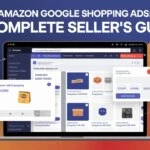Article Summary (TL;DR)
✅ Optimize Your Product Listings: Create high-quality product listings with compelling titles, descriptions, and images. Use relevant keywords and optimize your product pages for mobile devices.
✅ Build Strong Product Relationships: Identify complementary products and strategically bundle them together. Use the Frequently Bought Together Amazon feature to suggest these products to customers.
✅ Leverage Amazon’s Advertising Tools: Utilize Amazon’s advertising tools, such as Sponsored Products and Sponsored Brands, to promote your products and increase visibility.
The idea of cross-selling on Amazon isn’t new, but there’s a strategic way to amplify it that many sellers haven’t fully exploited.
Amazon’s “Frequently Bought Together” section holds tremendous power in shaping purchasing behavior, but most sellers aren’t leveraging this feature as effectively as they could.
The key isn’t just to hope that your product shows up there – it’s about positioning and creating a product strategy that directly influences Amazon’s algorithms.
So, how can you steer this powerful cross-selling tool in your favor?
Here’s how to move beyond the surface level and start positioning your products for serious revenue growth through the Frequently Bought Together Amazon recommendation engine.
Understanding the Algorithmic Logic
Amazon’s recommendation system is driven by a mix of purchase history, clickstream data, and consumer behavior.

“Frequently Bought Together Amazon” is no different. It shows up on your product listings when customers repeatedly buy specific combinations of products.
The system tracks thousands of these transactions, and when it notices consistent patterns, it begins suggesting those products to new customers.
Your job as an Amazon seller is to figure out how to nudge this algorithm so it starts pairing your products with others that make sense for your target audience.
Product Bundling Strategies for Frequently Bought Together Success
One of the most effective ways to increase your presence in the “Frequently Bought Together” section is by encouraging logical product pairings through bundling and promotions.
This is where the savvy Amazon seller can get strategic.
Consider your product catalog. What products naturally go together?

If you sell home organization supplies, it makes sense for a drawer organizer to be bought alongside shelf dividers or closet organizers.
The goal is to drive those sales through strategic pricing and promotional efforts to get the system to recognize a pattern.
Price promotions on complementary products:
Offer time-limited discounts when customers purchase complementary items from your catalog.
For example, “Buy an organizer and get 20% off closet dividers.”
When a customer adds both items to their cart, this signals to Amazon that these products belong together.
Create Amazon-exclusive bundles:
Go beyond the virtual bundling offered by many third-party tools.
Amazon offers a “Virtual Product Bundles” feature, which allows you to combine different items into a single listing.
A well-designed bundle can trigger increased sales velocity, encouraging the algorithm to pair those products in the “Frequently Bought Together” section.
Sponsored product campaigns for cross-promotion:
Run PPC campaigns that specifically target your complementary items.
Make sure that customers who land on one product are easily shown related products via headline ads or display ads.
This increases the chance of a customer adding both products to their cart and generating the data needed for the algorithm.
Influencing Customer Behavior through UX
Once you’ve strategically bundled your products, it’s time to focus on influencing customer behavior.

This is where you need to think about the user experience (UX) of your listings.
Your product descriptions and images should emphasize the value of purchasing multiple items.
If a buyer is looking at a hair dryer, don’t just show them the hair dryer – show them what they’ll need to complete the experience: a styling brush, heat protector spray, or a diffuser.
When they see how well these products work together, it encourages them to make a purchase.
Optimize your images for cross-sell:
In your product images, feature the complementary products that you want customers to buy.
This can be as simple as showing a lifestyle image where multiple products are being used together. It reinforces the idea that these products belong in the same cart.
Craft your product descriptions for add-on purchases:
In the product description, suggest other items that can enhance the primary purchase.
Mention how a specific product pairs perfectly with another, encouraging shoppers to consider the full package.
For example, “This hair dryer works seamlessly with our heat protector spray to keep your hair sleek and shiny.”
Managing Inventory and Logistics for Cross-Selling
If you plan to increase cross-sells, be prepared to manage the logistics. The last thing you want is for a customer to buy two products only to find out that one of them is out of stock.

This can negatively impact customer satisfaction and harm your overall conversion rates.
Ensure that your inventory is synced across all listings, especially when dealing with bundles or complementary products.
Investing in automated inventory management tools can help you avoid the headaches of overselling or running out of stock, which can cause a breakdown in your cross-selling strategy.
This is where Gorilla ROI’s integration solutions can streamline the process.
With automated data synchronization across your Amazon listings, you can keep track of inventory levels, sales velocity, and bundling performance in real-time.
You’ll be able to monitor which products are generating the most “Frequently Bought Together” traffic, adjust pricing or marketing accordingly, and ensure your products are always available for purchase.
Encouraging User-Generated Data for Cross-Sells
Another powerful way to encourage cross-sells is by focusing on social proof and user-generated content.

Customer behavior heavily influences what products are featured in the “Frequently Bought Together” section.
The more customers mention buying two items together in their reviews or post photos of those items, the more likely the algorithm is to catch on.
Encourage customers to leave reviews mentioning both products by using follow-up emails or Amazon’s “Request a Review” button.
Don’t just ask for a review—ask how the product worked with another item they purchased.
Even better, use your packaging to prompt customers to take pictures of their “complete” purchase. These organic mentions help reinforce product pairings in the algorithm’s eyes.
Leveraging Third-Party Data Tools for Deeper Insights
Here’s where sellers can gain an edge.
Using data-driven tools to monitor your sales patterns will give you the insights you need to refine your cross-sell strategies.
Amazon’s algorithm thrives on patterns, and it’s up to you to uncover them before your competitors do.
🗣️ Pro Tip: Utilize Gorilla ROI’s advanced data extraction and reporting features to pull detailed sales data.
This will help you identify which product combinations are trending in your sales history, and which bundles are moving the needle.
You can then adjust your marketing campaigns and product pairings based on real-time data, ensuring you stay ahead of the curve.
Monitor key metrics like:
- Average order value (AOV) when certain products are bought together
- How often certain items are being bought within the same session
- Conversion rates for product bundles or recommended pairings
With this data in hand, you’ll have a clear understanding of how to adjust your strategy to boost the visibility of your products in Amazon’s “Frequently Bought Together” feature.
Final Thoughts
Sellers who can tap into the potential of Amazon’s “Frequently Bought Together” feature will gain an advantage over their competitors.
It’s not just about hoping your products end up there by chance—it’s about influencing the system through strategic product pairing, data-driven decisions, and customer behavior.
By refining your bundling strategies, optimizing your listings, managing inventory, and leveraging third-party tools like Gorilla ROI, you can increase your cross-sells and drive significant revenue growth on Amazon.
Comments
Related Posts
Smart Guide to Import Amazon Data to Google Sheets
Running an Amazon business means juggling dozens of moving parts:…
The ultimate guide to Shopify marketing attribution: what works best for your business?
What you’ll learn Have you ever wondered where your customers…
Top 5 Strategies to Sustainable Shopify Growth: Turning One-Time Buyers into Lifetime Customers
What you’ll learn As a Shopify seller, you’re constantly looking…








Leave a Reply